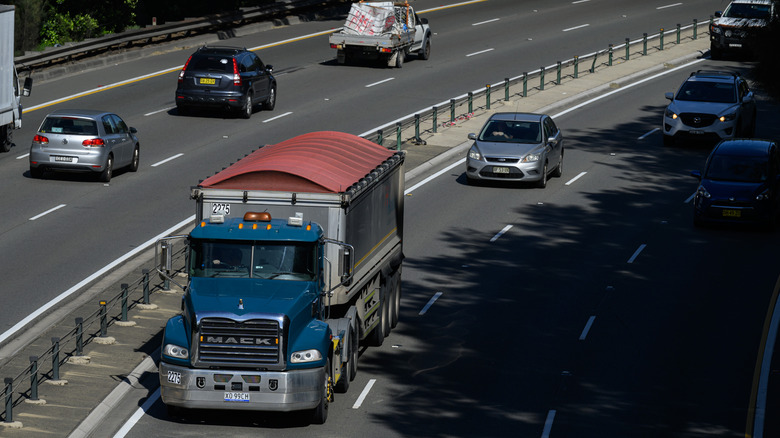Where Are The Blind Spots Of A Semi-Truck? How To Stay Safe While Driving Beside One
Thanks to their massive size and height, semi-trucks have some of the biggest blind spots you're likely to encounter on the highway. Also known as "No-Zones," these blind spots are where the truck driver has limited or no visibility of nearby vehicles. Because truck drivers rely solely on side mirrors (meaning no rearview mirror), vehicles lingering in these No-Zones are at risk of being sideswiped or cut off. These blind spots can be found directly in front of the truck's cab, behind the trailer, and along both sides of the vehicle. The No-Zone on the right side is particularly dangerous, as it extends across two entire lanes of traffic.
The front No-Zone extends about 20 feet ahead of the truck, so cutting in too closely can be an extremely dangerous thing to do. The rear blind spot extends up to 200 feet behind the trailer, making tailgating just as risky, since it reduces visibility and reaction time. The left blind spot is smaller than the right but still worth being aware of, and the right-side blind spot poses the greatest threat due to its larger coverage area and the driver's limited visibility on that side. Even with additional mirrors and cameras to help minimize the blind spots, truck drivers cannot eliminate them entirely. That's why it's so important for you to stay safe out there when you encounter one on the road. Here's what to know.
Staying safe when driving near a semi-truck
First and foremost, staying totally away from a truck's blind spots is the best way to prevent any accidents. A simple rule of thumb is if you cannot see the truck driver's face in their side mirror, they cannot see you. Therefore, avoid lingering in these No-Zones — especially when the truck is turning, changing lanes, or getting on or off the highway.
Semi-trucks require a lot more time to react and stop than smaller vehicles, so drivers should always maintain a safe distance. When passing a semi-truck, always do so on the left side and move past quickly but safely. Cutting off a semi-truck after passing is particularly risky, as the driver may not see your vehicle and may not have enough time to slow down.
When merging near a semi, ensure you are well ahead of the front No-Zone before moving into the lane. When following behind a truck, maintain a safe distance to allow for better visibility and reaction time. Additionally, be cautious when driving beside a semi-truck for extended periods of time. The larger the truck, the greater the force of wind it generates, which can cause your vehicle to sway.
Defensive driving tips when sharing the road with semi-trucks
Defensive driving is a great thing to practice when sharing the road with semi-trucks. Anticipate wide turns, as trucks often require extra space to maneuver, especially at intersections. Never attempt to squeeze between a turning truck and the curb, as this could result in a "squeeze play" accident, where the truck unintentionally traps the smaller vehicle.
While truck drivers know to check their mirrors often, they're also trusting you and other drivers to know to stay out of their No-Zones. This is especially true during nighttime when visibility is even lower. Trucks have reflective markings and lights to improve their visibility, but drivers of smaller vehicles should still exercise extra caution at night. Using high beams appropriately and avoiding unnecessary lane changes near trucks can help minimize risks.
Beyond this, stick to the common-sense fundamentals: always use turn signals early and clearly to communicate your intentions to truck drivers. This helps them adjust their driving accordingly, giving their larger vehicles more time to react. Staying alert and avoiding distractions while driving near semi-trucks can also reduce the risk of accidents.


